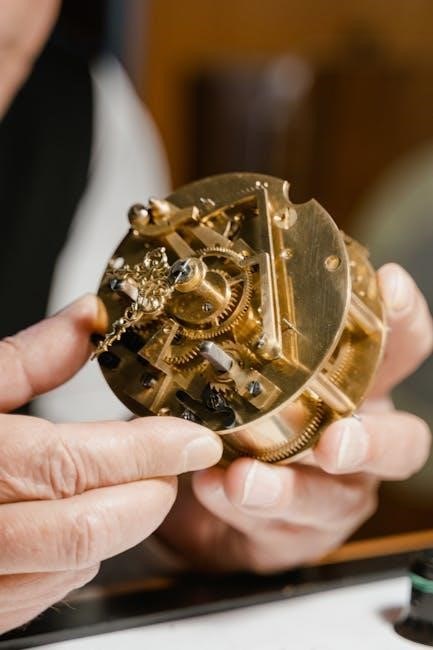Howard Miller clocks are renowned for their precision, craftsmanship, and timeless elegance. This guide provides essential instructions for setting up, operating, and maintaining your Howard Miller clock effectively.

1.1 Importance of the Instruction Manual
The instruction manual is crucial for understanding and properly operating your Howard Miller clock. It provides detailed guidance on setup, maintenance, and troubleshooting, ensuring optimal performance. The manual includes specific instructions for winding, adjusting the pendulum, and setting accurate time. It also covers unique features like chime functions and night silence mode. Following the manual prevents damage and extends the clock’s lifespan. For models with complex mechanisms, the manual offers clear, step-by-step directions. Additionally, it serves as a reference for identifying correct parts and accessing customer support. Regularly reviewing the manual helps users appreciate their clock’s craftsmanship and functionality. It is essential for both new and experienced owners to ensure their timepiece operates flawlessly.
1.2 Overview of Howard Miller Clock Models
Howard Miller offers a wide range of clock models, including grandfather, wall, mantel, and quartz clocks. Each model is designed with precision and craftsmanship, catering to different preferences. Grandfather clocks are known for their tall, elegant designs and pendulum-driven mechanisms. Wall and mantel clocks are more compact, ideal for home decor. Quartz models provide accurate timekeeping with minimal maintenance. Many models feature chime functions, such as Westminster or Ave Maria, adding a touch of tradition. Some clocks also include optional features like night silence mode. The variety ensures there’s a Howard Miller clock to suit every style and functional need. Manuals are available for each model to guide proper setup and operation.

Setting Up Your Howard Miller Clock
Unpack your clock carefully and locate the winding key included in the shipping carton. Follow the manual for proper setup, ensuring all parts are securely in place.
2.1 Unpacking and Initial Inspection
When unpacking your Howard Miller clock, carefully remove all components from the shipping carton. Inspect the clock for any visible damage or scratches. Locate the winding key, which is typically included in the box. Ensure all parts, such as the pendulum, weights, and hardware, are accounted for. Gently remove any protective covering from the clock’s surfaces. Before proceeding, verify that all mechanisms are intact and functional. If any items are missing or damaged, consult the manual or contact Howard Miller support immediately. Proper inspection ensures a smooth setup process and prevents potential issues down the line.
2.2 Locating the Winding Key
The winding key is an essential tool for operating your Howard Miller clock. It is typically included in the packaging and may be attached to the clock or placed separately. To locate it, check the box thoroughly, paying attention to compartments or small pouches. The key is usually small, T-shaped or L-shaped, with a rounded handle. If you cannot find it, refer to the packaging list or the manual. The winding key is crucial for powering the clock’s mechanism, so ensure it is readily accessible before proceeding with setup. Its proper use ensures smooth operation and accurate timekeeping.
2.3 Understanding the Pendulum and Weights
The pendulum and weights are vital components of your Howard Miller clock, ensuring precise timekeeping and smooth operation. The pendulum swings rhythmically, regulating the clock’s movement, while the weights provide the power needed to drive the mechanism. Typically, Howard Miller clocks feature a hinged or removable pendulum for easy adjustment. The weights are usually suspended from chains or cables and should be gently pulled to wind the clock. Proper installation and alignment of these elements are crucial to maintain accuracy. Always handle them with care to avoid damage. These components not only serve functional purposes but also add to the clock’s aesthetic appeal.

Operating the Clock
Start by ensuring the pendulum swings steadily and the weights are properly aligned. Monitor the clock’s accuracy and adjust as needed for optimal performance. Daily checks ensure smooth operation and maintain precise timekeeping. Always refer to the manual for specific guidance on operating your Howard Miller clock effectively.
3.1 Setting the Time Accurately

To set the time accurately, move the minute hand clockwise to the desired time, ensuring the clock is not chiming. Synchronize the hour hand by gently moving it to match the correct hour. Allow the pendulum to swing naturally to stabilize the timekeeping mechanism. Avoid rough handling, as it may disrupt the clock’s internal balance. For quartz models, simply adjust the time using the dial or button provided. Always refer to the manual for specific instructions, as some models may have unique features. Regularly check and adjust the time to maintain precision and ensure optimal performance over time.
3.2 Adjusting the Pendulum for Timekeeping
To adjust the pendulum for accurate timekeeping, ensure the clock is level and stable. Locate the adjustment nut at the bottom of the pendulum. Turning the nut clockwise will lower it, slowing the clock, while counterclockwise raises it, speeding it up. Avoid touching the pendulum directly to prevent oil residue. Adjust in small increments, allowing the clock to run for a few days to assess accuracy. Ensure the pendulum swings evenly for a steady tick-tock rhythm. If the clock is fast, lengthen the pendulum by moving the nut down; if slow, shorten it by moving the nut up. Keep the clock wound and check against a reliable time source for optimal performance.
3.4 Understanding Chime and Alarm Functions
Howard Miller clocks often feature chime and alarm functions, enhancing their traditional appeal. The chime function plays melodious sounds, such as Westminster or Ave Maria, at specific intervals, typically on the hour. To activate or deactivate chimes, locate the chime selector switch, usually found on the back or side of the clock. For alarms, set the desired time using the alarm dial, and ensure the alarm is turned on. Some models allow volume adjustment for chimes. Refer to your manual for specific instructions, as features may vary by model. Properly managing these functions ensures your clock remains a delightful and functional timepiece in your home.

Maintenance and Care
Regular maintenance ensures optimal performance. Dust surfaces with a soft cloth, and lubricate mechanical parts annually. Avoid harsh chemicals or excessive moisture to preserve finish and function.
4.1 Regular Winding and Lubrication
Regular winding is essential for mechanical Howard Miller clocks. Wind the clock weekly using the provided key, turning it clockwise until resistance is felt. For weight-driven clocks, lift weights gently to their highest position. Lubricate mechanical components annually with high-quality clock oil to ensure smooth operation. Avoid over-lubrication, as it can attract dust and degrade performance. Proper winding and lubrication maintain accuracy and extend the clock’s lifespan. Always follow the manufacturer’s recommendations for lubrication frequency and type to preserve your timepiece’s functionality and elegance. Regular maintenance ensures your Howard Miller clock remains a reliable and beautiful addition to your home.
4.2 Cleaning the Clock Mechanism

Cleaning the mechanism of your Howard Miller clock is crucial for maintaining its accuracy and longevity. Begin by stopping the clock and removing any weights or pendulum to access the internal components. Use a soft, dry cloth or a small brush to gently remove dust and debris from visible parts. Avoid using harsh chemicals or excessive moisture, as they can damage the finish or harm internal workings. If necessary, lightly dampen the cloth with distilled water, but ensure it is thoroughly dry before reassembling. For intricate areas, use compressed air carefully to avoid pushing debris further into the mechanism. Regular cleaning prevents dust buildup and ensures smooth operation. Always refer to the manual for specific guidance, and consider consulting a professional if unsure.
4.3 Storing the Clock Properly
When storing your Howard Miller clock, ensure it is placed in a clean, dry environment to prevent damage. Avoid exposure to extreme temperatures or humidity, as this can affect the mechanism; If possible, store the clock in its original packaging to protect it from dust and scratches. Remove the pendulum and weights to prevent damage during storage. Secure any loose parts and keep the clock upright to maintain balance. Do not stack items on top of the clock, as this could cause structural harm. For extended storage, consider consulting a professional to prepare the clock properly. Store it in a stable location to preserve its condition.

Troubleshooting Common Issues
This section addresses frequent problems like timekeeping errors, chime malfunctions, and mechanical issues. Identify symptoms, diagnose causes, and apply solutions to restore optimal clock performance effectively.
5.1 Timekeeping Errors and Solutions
Addressing timekeeping errors is crucial for maintaining your Howard Miller clock’s accuracy. Common issues include the clock running slow, fast, or stopping entirely. First, ensure the clock is properly wound and the pendulum is swinging steadily. If the clock loses time, adjust the pendulum by moving the regulation nut up or down. For persistent inaccuracies, check the escapement and balance wheel for proper alignment. Lubricate the mechanical components if necessary. Environmental factors like temperature and humidity can also affect accuracy. Consult the manual for specific adjustment instructions or contact Howard Miller support for professional assistance. Regular maintenance can prevent such issues.
5.2 Issues with Chimes and Alarms
Issues with chimes and alarms on Howard Miller clocks can disrupt their functionality. Common problems include chimes not sounding, incorrect chime timing, or alarms failing to activate. First, ensure the clock is properly set up and the chime selector is correctly positioned. Check the volume control to confirm it is not muted or turned down. Verify that the alarm time is accurately set and the alarm switch is engaged. If issues persist, consult the manual for reset instructions or perform a gentle cleaning of the chime mechanism. For complex problems, contacting Howard Miller customer service or a certified technician is recommended to resolve the issue effectively.
5.3 Repair and Replacement Options
For extensive damage or complex issues, professional repair or replacement may be necessary. Howard Miller offers authorized service centers where skilled technicians can address mechanical or electrical faults. For minor repairs, such as replacing worn parts or adjusting components, genuine replacement parts are recommended to ensure compatibility and performance. Contact Howard Miller customer service for guidance or to locate an authorized repair provider. If a clock is beyond repair, consider purchasing a replacement model, as continuing to use a damaged clock can lead to further complications. Always follow official repair channels to maintain the clock’s warranty and functionality.

Advanced Features and Customization
Explore advanced features and customization options to enhance your Howard Miller clock’s functionality and aesthetics. Learn how to personalize settings, optimize performance, and tailor your clock to your preferences.
6.1 Setting Up Night Silence Mode
To enable Night Silence Mode on your Howard Miller clock, locate the silence switch or button, typically found near the clock’s mechanism or control panel. This feature disables chimes during designated nighttime hours, usually between 10 PM and 7 AM, ensuring uninterrupted sleep. Some models allow customization of the silent period, which can be adjusted by moving a small lever or pressing a sequence of buttons. Refer to your manual for specific instructions, as the process may vary slightly depending on the model. Once activated, the clock will automatically suspend chimes during the set hours, resuming normal operation at the end of the silent period.
6.2 Customizing the Clock’s Appearance
Howard Miller clocks offer various customization options to match your home decor. Many models allow interchangeable pendulums, weights, and finials, which can be swapped to suit your style; Some clocks feature adjustable dials or bezels that can be rotated to change the clock’s aesthetic. For illuminated models, brightness levels can often be adjusted. Additionally, certain clocks permit the addition of engraved nameplates or personalized messages. Always refer to your specific model’s manual for guidance, as customization options vary. Ensure any modifications are compatible with your clock’s mechanism to maintain proper functionality and avoid damage.
6.3 Adding Optional Features
Howard Miller clocks allow for the addition of optional features to enhance functionality and personalization. Some models support extra chime rods for unique sound options or LED light kits for improved nighttime visibility. Certain clocks can also be equipped with interchangeable pendulums or weights to match your decor. Additionally, some models offer digital features like Bluetooth connectivity or smart app integration. Always check your clock’s compatibility before adding any optional features. Refer to the manual for installation instructions to ensure proper setup. Test the clock thoroughly after adding new features to confirm they function as intended and do not disrupt the clock’s timekeeping accuracy.

Resources and Support
Access official manuals, guides, and troubleshooting tips.
Contact Howard Miller’s support team via phone, email, or live chat.
Join forums for peer advice and solutions.
7.1 Accessing Official Manuals and Guides
Visit the official Howard Miller website to download PDF versions of instruction manuals.
Search by clock model or product number for quick access;
Authorized dealers may also provide printed or digital copies.
Contact customer support directly for assistance.
Ensure you verify the authenticity of the source to avoid incorrect information.
Additional resources, like troubleshooting guides, are often included.
Use the website’s search bar for easy navigation.
7.2 Contacting Howard Miller Customer Service
Contact Howard Miller’s customer service team for assistance with your clock.
Call their toll-free number or use the contact form on their website.
Email inquiries are also accepted for troubleshooting or repair needs.
Customer service is available Monday–Friday during business hours.
For urgent matters, phone support is the fastest option.
Provide your clock’s model number for quicker assistance.
Check the official website for the most up-to-date contact information.
7.3 Online Communities and Forums
Engage with online communities and forums dedicated to Howard Miller clocks.
These platforms offer valuable insights, troubleshooting tips, and user experiences.
Websites like Reddit and specialized horology forums host discussions.
Share knowledge with fellow clock enthusiasts and experts.
Find maintenance advice, repair guidance, and customization ideas.
Participate in threads to resolve common issues or learn new techniques.
These communities often include vintage and modern clock discussions.
While not official support, they provide peer-to-peer assistance.
Use forums to connect with others who appreciate timepieces.
Remember to verify advice with official guides for accuracy.
